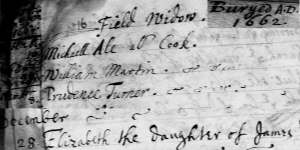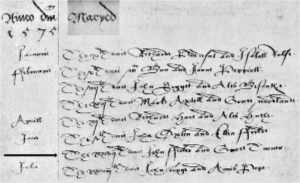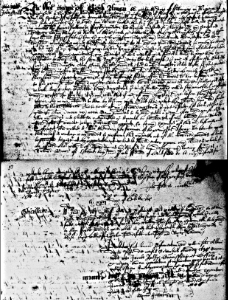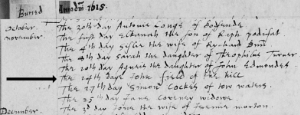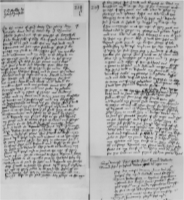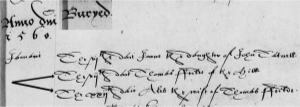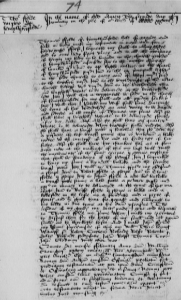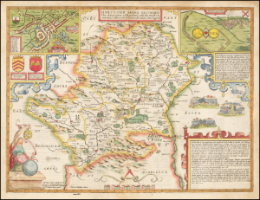Elizabeth Wildes' Ancestors |
Click on a name for info, click on an arrow to follow that branch, click Home to go to the main page, or click for an Alphabetic List of all Names. |
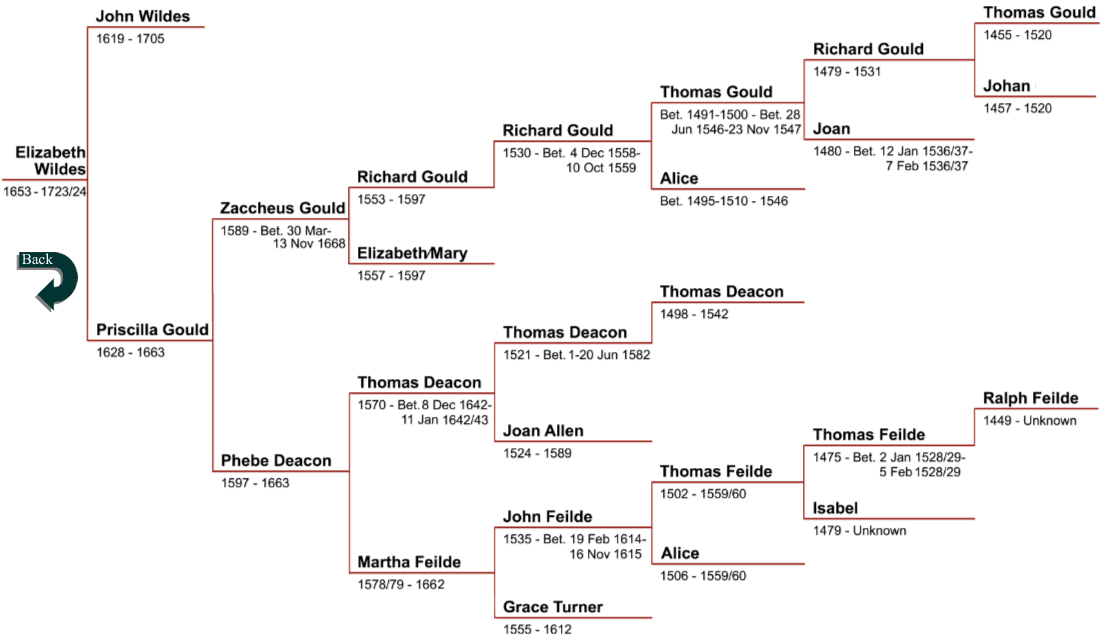 |
| Note: Before 1752 the year began on March 25th. Dates between January 1st and March 24th were at the end of the year, not the beginning. |
John Wildes’ ancestry is uncertain. What we know of John is from his New England records. His surname has been recorded with many different spellings: Wile, Wiles, Wild, Wilds, Wilde, Willde, Wylde, Wyldes, and many others. He was born about 1619, as in three different depositions his name and age are recorded as follows: on June 26, 1660, John Wildes, aged about forty years; on June 27, 1665, John Wiles, aged about forty six years; and on March 30, 1669, John Wild, aged about fifty years. Where he was born, raised, or who his parents were are unknown. There was a 17-year-old Jo Wild who came to America, listed with the family of William Whittridge, a carpenter from Lilley, Hertfordshire, England, on the ship Elizabeth, which departed Ipswich, Suffolk, England on June 12, 1635. Also on this passenger list was a 40 year-old Alice Wild and a 30 year-old William Wild, who was also a carpenter. Walter Davis, Jr. states in his article The Wildes Family of Essex County, Massachusetts, that on the ship’s manifest, Alice’s relationship is not listed, but John was listed as William’s brother, and that “This list of passengers, . . . is among the records of the London Custom House, . . .” If this is true, William, could be John’s full or half-brother and Alice could be John’s mother but not William’s. In William’s 1662, New England will, William Wild of Ipswich calls both John and his son John Jr. his kinsman, not brother: “John wild the sonn of John wild of Topffield my Kinfman . . . my Kinfman John wild Senior of Topffield” and “. . . my Kinfman John wild Junior. . .” If he was a brother, why not call him that-he could have been an uncle? Also in his will, William mentions his wife, but no children, leaving his house and land to John after his wife Elizabeth’s death. From this will we can see they are closely related, but how is uncertain. Unfortunately, Alice is not mentioned in the Massachusetts records. Davis tells us that John lived in Ipswich and in 1639 fought in the war with the Pequot Indians, receiving 12 shillings a day in 1643. Davis estimated that in 1645, after his military service, John moved to Topsfield, Essex County, Massachusetts, then called New Meadows. In Cyrus Mason Tracy’s book, Standard History of Essex County, Massachusetts, he states that John Wildes was “among the original proprietors of land at New Meadows.” He probably met his future wife, Priscilla Gould, there and married her about 1648. They had at least eight children, see Priscilla’s bio for details on the children. John worked as a carpenter, and may have learned his trade from William Whittridge or William Wild, both mentioned above. The first mention of his name in the Records and Files of the Quarterly Courts of Essex County, Massachusetts, Volume 1, is dated June 30, 1646 at a court held at Salem. John Wilds and Lt Howard were paid 2li. 18s. 10d. There are several entries with his name, but the first that places him in Topsfield is a court record of June 25, 1661, where he signs his name John Wyld constable of Topsfield. Davis tells us that the first record he found for John in Topsfield “is a deed of sale, dated July 15, 1654, from John Wilds, carpenter to Robert Andrews, for twenty acres of upland . . .” Tracy tells us that in “1661, the common lands on the south side of the river were laid out” to several folks including John Wiles. Then in “1664, the land on the south side of the river, which was still common, was divided among the several inhabitants of the town that paid to the minister's rate.” John was among these men. John’s wife Priscilla died in April of 1663, leaving him with eight children, the oldest being about 14 years old and the youngest being only four-months old. On November 23, 1663, seven months after Priscilla’s death, John married Sarah Averill. Unfortunately, this marriage was not looked upon fondly by Priscilla’s siblings Mary (married to John Redington) and John Gould, both of whom lived close by. Sarah was raising Priscilla’s children, and John and Mary were probably worried about their deceased sister’s inheritance to come. Meanwhile, John and Sarah had a son, Ephraim, born in February of 1665/66, and, John’s name was mentioned in the court and town records many times, including serving on committees, as surveyor, as a jurymen and being a member in full communion of the Topsfield Church. Then things went bad. Davis states, “The first intimation of this state of affairs, appears in the statement John Wild, Jr., made in his will, regarding his Gould inheritance, in order that his father might not be troubled by any claims of his uncle Gould.” Unmarried John Jr. wrote his will on October 22, 1676, and it was proved in September of 1677. His will was basically a statement protecting his father from his uncle John Gould, and leaving everything to his surviving siblings, including his half-brother Ephraim. John’s position as surveyor, made him many enemies in Salem, as border disputes between Salem and Topsfield came out in Topsfield's favor. Then on August 5, 1686, John Wildes testified against John Gould, who was charged with treason. Davis says “Shortly after this episode, Mary Reddington began to spread witchcraft stories about Sarah Wild through the town and it is to her authority that most of the evidence against Sarah Wild may be traced. When John Wild threatened to sue her husband for slander, she denied her previous statements, but evil had already been wrought.” A few years later on April 9, 1690, John transferred everything he owned to his only surviving son Ephraim. This may have fueled the flames of hatred even more. On April 21, 1692, a warrant was issued for John’s wife Sarah, his daughter Sarah and her husband Edward Bishop. By now, Sarah and John’s son Ephraim was the constable of Topsfield, and it fell to him to have his 65 year-old mother, his half-sister and her husband arrested. Over the next few months, John and Ephraim tried to get them released, but Sarah Wildes was hung as a witch on July 19th with several others including Susanna (nee North) Martin, the sister of ancestor Mary North.
|
| ~< Back to Chart >~ |
Sadly, Priscilla didn’t watch her children grow-up, she died in Topsfield, on April 16, 1663, prior to her father’s death. Her share in his estate was paid to her children by her brother John Gould. (Mouse over the image on left, which lists son Nathan's birth and death; Priscilla and her mother Phebe's deaths; and John Wildes' marriage to Sarah Averill, and click on it to enlarge it in a new window/tab.) |
| ~< Back to Chart >~ |
Zaccheus Gould was born about 1589, most likely in Bovington, Hertfordshire County, England, the youngest of six children born to Richard Gould and his first wife. The only proof of his birth year comes from a deposition he made at the Salem Court on March 26, 1661, where Zaccheus stated that he was seventy-two years old. Most of the information printed here comes from the research of many others, including, but not limited to: Benjamin Apthorp Gould’s, The Family of Zaccheus Gould of Topsfield; Archibald F. Bennett’s, The Ancestry of Joseph Smith; and the research of Charles Farrow of the Towne Family Association, as reported by Barbara H. Holt in her book, The Deacons of Cornerhall. Zaccheus married Phebe Deacon about 1619/20, probably in Hemel Hempstead, Hertfordshire County and they had five children together- see her bio for details. Phebe and Zaccheus most likely lived in Hemel Hempstead until about 1628, as his first three children were baptized there. By the Fall of 1628, the family was living in Great Missenden, Buckinghamshire County, England, where he was assessed in 1629. Gould family tradition says that in Great Missenden, they “lived at a place called Hunts Green near Potter Row. . .” They lived there at least until 1633, when his son was baptized. It is believed that the family immigrated to the New World about 1635/36, as Ship Money Records for Zaccheus for the year 1635, were found at the UK National Archives by Charles Farrow. By 1639 the family was living in New England where Zaccheus bought land from his older brother Jeremy in Weymouth, Norfolk, Massachusetts. In 1640, Zaccheus owned a mill on the Saugus River and was living in Lynn, Essex County, Massachusetts, where he leased a farm of 300 acres called the Plains for ten years. But a few years later, he bought land in Ipswich from William Paine, and moved his family there. Benjamin Apthorp Gould states, “In 1651 he took the oath of fidelity, Sept. 30, but he never became a ‘freeman’ of the colony, for which position it was necessary for him to become a member of the church.” His name is mentioned dozens of times in the The Massachusetts Bay Colonial court and town records as plaintiff, defendant or witness, which give us much insight into the personality of the man: • The first mention that this researcher has found was for Court held at Salem on March 29, 1640, where it simply says, “Daniel Fairefield v. Zacheus Gould. Trespass.” • Also in that same year on October 7, 1640, there is “The humble petition of Zaccheus Gould of Lynn, husbandman, in behalf of himself and all other husbandmen in the country.” This petition was asking for farmers to get the same exemption from training as fishermen have “because their trade is also for the Commonwealth.” On December 30, 1643, at a Court held at Salem, “William Tayler, servant to Zacheus Goold, to be severely whipped for stealing, and to make double restitution.” • Sometime prior to May 29, 1644, the date petition was granted, Zaccheus along with others, petitioned the General Court of Massachusetts, for a village to be incorporated where he now lived, and wanted to call it Hempstead, probably after Hemel Hempstead. But Gov. Winthrop decided it was to be called Toppesfeild, which soon became Topsfield. • On December 25, 1649, at a Court held at Salem, “Humferey Broadstreet v. Zacheus Gold. For taking away and detaining his horse, being legally demanded by his assignee.” • On September 30, 1650, at a Court held at Ipswich, “Zacheous Goold took the oath of fidelity.” • On April 24, 1656, at a Court held at Ipswich, “Zacheous Gould presented for absence from meeting on the Lord's day. Proved . . . for not frequenting the public ordinance upon the Sabbath days.” • On September 28, 1658, at a Court held at Ipswich, “Zacheous Goold to be summoned to appear at next court to answer complaint of abusive carriages in the meeting house.” At the next meeting held in Ipswich court on March 29, 1659, the whole story came out. It seems the witnesses against him were William Perkins, who was the officiating minister, although there is no record that he was ever ordained, and Isaac Cummings, whose name appears on various complaints in the records against Zaccheus and his son John. Perkins and Zaccheus knew each other long before Perkins came to be the minister of Topsfield. Perkins had been a resident in Roxbury and Weymouth, and in April of 1645, Zaccheus sold his estate at Weymouth to Perkins. Three months later in July, Zaccheus sued Perkins for a debt. So the relationship between these three men wasn’t a friendly one. Both Perkins and Cummings swore in the Ipswich court “that Zacheus Gould in time of singing ye psalm one Sabbath day in ye after-noone, sate him downe upon ye end of ye Table (about wch ye minister & cheife of ye people sit) wth his hatt fully on his head, & his back toward all ye rest of ym yt sate about ye Table & though spoken to by ye minister & 2 others, ether to shewe reverence to ye Ordinance, or to wthdrawe, yet altered not his posture & ye Sabbath following, after that the Congregation was dismissed in ye afternoone, desired ye Congregation to stay & thereupon spake saying yt hee bad bin informed how yt ye last Sabbath day hee had bin commanded out of the meeting house, but it was not for want of age, nether had hee anything to doe yt commanded him, for ye house was non of his—also he sd that he had heard much speech of ye ministers of Christ, & hee confest also, that they could not bee too much honored, but sd hee we knowe yt there bee a Company of hirelings who if they fre not their mouthes they prepare warre agst yu, such Micah speakes of Chapt 3d v. 7th — see John 10th— wch hee sd hee would not reade but they might reade at their leisure— also hee added that hee had bin informed what a learned speech ye goodma Coms made, but he was told by some or one, yt was now mor nearely Related to him, yn himselfe yt hee was a proud, probmatical, base, beggarly, pick thank fellowe, whereupon hee was desired to hold his peace, but hee replied yt they had nothing to doe to injoyne him silence, ye house was none of theirs who did injoyne him, whereupon hee was told yt hee would finde ye contrary, whereupon hee oft dared us to do our worst.” Other witnesses said that during Perkin’s sermon “Zacheus Gould spoke audibly” and that “Zacheus Gould said that Mr. Perkins was an hireling, and therefore none of them.” Zaccheus was charged 18 shillings as “The order of the court was that the defendant be admonished.” • A few months later on November 12, 1659, Zaccheus was found guilty of entertaining Quakers, and was fined £3. He welcomed into his home Daniel, the son of his brother Jeremy, who recently became a Quaker. Daniel was sentenced to be whipped with thirty stripes and had to leave within five days or be thrown into prison. Zaccheus’ £3 fine was later remitted in the spring of 1660 because his property had sustained some serious losses due to a fire. This is just one example of how the community felt about the approved religion and how they treated dissenters. Zaccheus himself seemed to be fairly liberal about religious matters, being friendly both to the Baptists and the Quakers, neither of whom were looked upon with favor by the prevailing religion. There are many more mentions of him in the records. The last found in his life time is at a Court held at Ipswich, on September 24, 1667, where “Daniel Hovey . . .was fined and ordered to pay costs to Zacheous Gould.” Even for many years after his death, his name is mentioned in the records. In Cyrus Mason Tracy’s book, Standard History of Essex County, Massachusetts, he states, under the Topsfield subheading, that in “1661, the common lands on the south side of the river were laid out” to several folks including Zacheus Gould. Under the Boxford subheading Tracy states, “Boxford now bore the name of Rowley Village, although it was a part, and subject to the authority of, Rowley. Most of the early settlers were extensive land-owners; but the largest tracts were owned by Joseph Jewett, of Rowley, and Zaccheus Gould, of Topsfield, who together had more than six thousand acres.” Bennett states that “Zaccheus Gould was probably the largest land owner in the district where he lived; owning at his death not less than 3000 acres, much of which later became the town of Boxford.” So it is not hard to see that he had the respect and esteem of his community. His wife died in 1663 and his death occurred about five years later, some time between March 30th and November 13th of 1688. Some researchers say he was buried on land near the town meeting house. There is a large memorial stone monument in the Pine Grove Cemetery in Topsfield for him and his son John. (Mouse over the memorial image on left to see a close up of the inscription.) |
| ~< Back to Chart >~ |
It is believed Phebe came to America with her husband and children in the second half of 1635 or early in 1636, and eventually settled in Topsfield, Essex, Massachusetts. (Mouse over the photo of their Topsfield house on right for more info about it.) Phebe Deacon Gould died there on September 20, 1663. The Topsfiled town record of her death lists her as Phebye the wife of Zaacheous Gould. She was probably buried in the Topsfield churchyard. |
| ~<^>~ |
Richard Gould (Jr.) was born about 1553, probably in Bovingdon, Hertfordshire, England, to father Richard Gould Sr. and his wife. Both of his parents died before he was six years old, and it is not known who raised him to adulthood. Researchers say Richard Jr. was married about 1578, and his wife’s name was Mary, but there is no documentation to support this. Vital records for this area and time are missing. The notice of settlement of his estate mentions a wife named Elizabeth. Which woman was the mother of his children is unknown, but some researchers say it was Mary and after her death, he married Elizabeth. He had six children, with one or two wives — Richard (3rd) born about 1578, married Mary Golder, on May 16, 1625, at St Mary’s Church in Chesham, Buckinghamshire; Jeremy, born about 1581, married Priscilla Grover on November 25, 1604, in Chesham at St Mary’s Church, immigrated with her to Rhode Island, after she died there, returned to England; Sarah, born about 1583, may have married Nathan Ware of Chesham, about 1612/13; Priscilla, born about 1585, married John Putnam, and came to America with her husband; John, born about 1587, married a woman named Judith, died in 1633 and was buried on July 11th in Kings Langley, Hertfordshire, England; and ancestor Zaccheus. Richard Gould (Jr.) died prior to May 5, 1597, the date of his probate administration, at the age of 44. His will has not been found, but A. Vere Woodman, F.S.A. has abstracted the following probate record as printed in the article Priscilla, Wife of John Putnam, by Read H. Putnam: “Court held in Baldok Parish church 25th May 1597. The Lords official against Elizabeth Goulde widow of Bovingdon, administratix of the goods of Richard Goulde of the same deceased in a matter of the account.” The judge “decreeed that Sara and Priscilla Gould of Bovington, the natural and lawful daughters of the deceased in particular be cited to be at the next court and that notice be given to all others in general having, or pretending to have, a right, title, or interest in the goods of the same deceased To be in the parish church at Bovingdon to see the account of the said Elizabeth exhibited and to object if they think fit. . . .The matter was finally settled at the court held in the parish church of Berkhamstead St. Peter, 1 July 1597, when the account was presented. No one objected so a letter of acquittance called 'a quietus' was issued under the seal of the Lord [Judge].” Unfortunately this does not clarify if Elizabeth is the natural mother of Richard’s (Jr.) children. This researcher believes the mother to be Elizabeth and feels that other researchers may have confused, their son Richard’s (3rd) marriage to Mary Golder with his father, Richard Jr. |
| ~< Back to Chart >~ |
Thomas Deacon was born about 1570, probably in Bovington, Hertfordshire County, England, to Thomas Deacon and his wife Joan Allen. He was the fourth of his name in this line and is identified as a minor son in the will of his father. A birth record has not been found, but his birth year is based on the fact that he was under 21 years old when his father wrote his will in 1582, and detailed information found in the Manor Court Books of Hemel Hempstead by Charles Farrow of the Towne Family Association, as reported by Barbara H. Holt in her book The Deacons of Cornerhall: In June of 1593, Thomas, with three other young men, were accused of illegally fishing in a stream belonging to the Lord of the Manor in Hemel Hempstead. (Bovingdon is 4 miles from Hemel Hempstead.) Then on June 17, 1595, the Steward of the Manor granted to Thomas and his brother Roger Deacon and their heirs forever, at the will of the Lord of the Manor, one rood (one quarter of an acre) at Cornerhall. Holt continues, “on 25 May 1619 the Manor Court admitted Thomas Deacon to a cottage with a hearth and garden in Corrnerhall. Immediately afterwards Thomas surrendered that property to William Puddefat. Two years later, on 29 May 1621, William surrendered it back to Thomas Deacon, with the addition of a stable. Thomas Deacon went on to make other small acquisitions of land in the later 1620’s. On 22 May 1627 he was allowed to occupy one acre of arable land in Crouchfield Common and on 10 June 1828, was admitted by the Court as a tenant of that property. The same day, he was admitted to a cottage of ‘two bays with appurtenances’ in Cornerhall which had been held by Joseph Martyn, a Doctor of Medicine.” In Susan Yaxley’s History of Hemel Hempstead, she states that Thomas “became affluent and well established there as a tanner . . . His house consisted of a hall, kitchen and brewhouse, with three chambers above, and a garret above this; he had a tanyard with two sheds which had lofts above.” She goes on to say, “There is ample evidence that the Deacons continued to carry on the business on and off during the eighteenth century. The property remained in use as a tannery throughout the nineteenth century . . .” Later in his life Holt states Thomas began to divest himself of his property. On October 16, 1630, he “surrendered his piece of arable land on Crouchfield Common . . . to Richard Chadley Jnr.” On March 24, 1631, he “surrendered many of his other holdings to his eldest son Elisha . . .” On June 7, 1631, he was accused “of encroaching on the waste land of the Manor beside the King’s highway in Cornerhall, having erected a boundary fence and a building called an Outlet there. He was ordered to remove them before 29 September 1631.” Six years later in 1637, Thomas became the bailiff of Hemel Hempstead.
|
| ~< Back to Chart >~ |
|
| ~< Back to Chart >~ |
Richard Gould was born about 1530, probably in Bovingdon, Hertfordshire, England, one of eight children born to Thomas and Alice Gould. One researcher claims he was born on May 22, 1530, but gives no supporting documentation. Being that all of Bovington’s records for this time period were burned, knowing the exact date is highly unlikely. Richard married, but her name is unknown, and they had two sons — ancestor Richard and Henry, who was born about 1555, married Alice, and died at the age of 48. It is assumed they lived in Bovington. Richard’s first wife apparently died and he married Jane, who was a widow with the married name of Weeden, with several children. This researcher assumes it was with this marriage that Richard and his family, moved to his new wife’s home in Stoke Mandeville, which is only 12 miles northwest of Bovingdon. It is clear from the abstracts of both of their wills, printed in Benjamin Apthorp Gould’s The Family of Zaccheus Gould of Topsfield, that Jane was not the mother of ancestor Richard and Henry. When his father died in 1546/7, Richard inherited “sexe hunderide of felows of beichie tymber, ij hunderide of spoks, one peyre of sheats ij platterys, a sawcere and a candlesticke.” Richard Golde wrote his will in Stoke Mandeville on December 4, 1558, and calls himself “of Bovingdon and Stoke Mandeville.” He requests to be buried in Bovington, possibly where his first wife is buried. He mentions his wife Jane, but only his two sons, and names Jane’s daughters, Alice and Jane Weeden, as his own. They were probably young when he married Jane and he grew fond of them. B.A. Gould states in his book, “The will is somewhat decayed, and a portion of it is destroyed.” Richard’s will was proved on October 10, 1559, which means he died either late in 1558 or earlier in 1559, about 29 years old, leaving two young sons. Joan Golde wrote her will in Stoke Mandeville on June 26, 1559. In it, she mentions a son, only by his given name, William, and three unnamed daughters. Some researchers believe William was Richard Gould’s son, but if he was, why didn’t Richard mention him in his own will? Jane wished to be buried in Stoke Mandeville, which one may assume, because she wanted to be buried with her deceased Weden husband. Her will was proved March 29, 1560, so she died sometime between the will date and the proved date. Richard and Jane dying so young left several underage children, and unfortunately, it is not known who raised these children to adulthood. It is assumed that Richard’s request to be buried in Bovingdon, meant in the St. Lawrence Churchyard, but at this time Bovingdon had a non-conformist chapel also. St. Lawrence wasn’t an independent parish then. A Brief History of St Lawrence Church, Bovingdon, states “Although Bovingdon was only a chapelry of Hemel Hempstead, the inhabitants claimed that it was an independent parish. After all, the village had parochial officers of its own, maintained its own poor and had baptisms, marriages and funerals performed in the church.” Bovingdon finally became a separate parish in 1834 and the current St. Lawrence Church building was built in 1845. |
| ~< Back to Chart >~ |
Thomas Deacon’s birth is said by some researchers to be April 20, 1521, in either Hemel Hempstead or Bovingdon, both in Hertfordshire, England, the only known child born to Thomas Deacon and his wife, Elizabeth, but they give no documented proof. It is very unlikely that Thomas was born in either Hemel Hempstead or Bovingdon, as Consulting Genealogist, Charles Farrow reports in his 4 part article, The Joseph Towne Connection: the Deacon, Gould and Perkins Families (printed in the Towne Family Association newsletter, About Towne, volume XXXIII, No. 1), there is no record of Deacons in Hemel Hempstead or Bovingdon until a house lease issue places them in Bovingdon in 1560/1. What we know of him comes from his will, so his ancestry is uncertain. Thomas married Joan Allen and they had at least five children, all probably born in Bovingdon in the 1560’s and 70’s — daughter Awdrey married Matthew Robson on January 16, 1586/87 in Hemel Hempstead, Hertfordshire; Margaret married John Ewer, had at least two children, and died prior to March 3, 1645/6, the date her will was probated; Marie was the youngest daughter; ancestor Thomas; and Roger, who is identified as a minor son in the will of his father, married Annis Turner in St Mary's Church, in Hemel Hempstead, on June 2, 1596, and died in the first half of 1650. (Some researchers, in error, have added another daughter who was deceased prior to her father’s will, who was married to John Ewer, because Thomas bequeath to his Ewer grandchildren. These grandchildren were the children of his above mentioned daughter, Margaret.)
“In the name of God Amen the first daye of June in the yere of our Lord God 1582 I Thomas Deacon of Boveingdon in the Countie of Hertford yeoman beinge sicke in bodie but of good & perfecte memorie laude & praise be unto Almightie God do make & ordayne my last will & Testament in manner & forme followinge. First I comend my sole into the handes of Almightie God my maker & redeemer & my bodie to be buried in Boveingdon churchyeard. Item I geve & bequeth to the poore in Boveingdon 16d. Item I geve & bequeth to my three Daughteres Awdrey Margeret & Marie to eche of them the some of £13 6s 8d of good & lawfull monye of England & to eche of them as followeth that is ech of them one cowe, 10 shepe, one cofer [small chest] the best save two, one paire of flexen [flax] shetes & two payre of toane sheetes one table cloth & halfe a dizen of napkins one candlesticke two pewter platters & two pewter dishes one matterise one coverlet, one blanket one bolster one pillowe and one paire of pillowbeers [pillow cases] one bearinge sheet & one brasse pott. Item I geve & bequeth to my two sonnes Roger & Thomas eche of them the some of £40 of lawfull monye of England to be payd within three yeres next after the feaste of St Michaell tharkangell next comynge after the date hereof to the overseers of this my last will & Testament & they to imploye at yerelye to the best use of the said Roger & Thomas untill eche of them come to the age of 21 yeres & then my said overseers to deliver the said somes of £40 a peece unto the said Roger & Thomas their heires or assignes. Item I geve & bequeth to William Ewer & Anne Ewer the sonne & daughter of John Ewer my sonne in lawe eche of them an ewe pugge of an yeare olde. [An ewe pug is normally 2 years] Item I geve to William Parret Franncis Axtell & John Feilder eche of them 12d & to Henrye Style 8d. The residue of all my goodes & Chattels not bequethed I geve & bequeth to Jone my wiffe & I make & ordayne the said Jone my wiffe & Richard Allen her brother executores of this my last will & Testament & he to have for his labor 40s and to have all his charges borne about the executinge of this my last will, & I ordayne Henrye Mayne & John Goold of the lane overseers & they to have eche of them for their la-bores 13s 4d. Witnesses hereof Thomas Hallam Raphe Bullocke John Deacon & Thomas Fielde with others. 22nd June 1582 approved and administration granted to Richard Allen.” From this will we learn Thomas’ wife’s maiden name and her brother’s given name. With this information, other researchers have decided that Joan and her brother Richard were the children of Roger Allen and his wife Anne Rogers, but give no sources. This researcher has not found any documents to confirm this parentage, so Joan’s line ends with her. Thomas' will was probated on June 20, 1582, which means he died sometime between the writing of his will on June 1st and this probate date. It is assumed that his burial request was honored and he was buried in the St. Lawrence Churchyard in Bovingdon. Some researchers say Joan Allen Deacon died on July 28, 1589, in Bovingdon, but give no supporting documentation to support this date. |
| ~< Back to Chart >~ |
Less than a year after their last child was born, John’s wife Margerie died and was buried on May 13, 1573, in St. Mary’s Churchyard. John, left with young children did not marry again for two years.
In the Hertfordshire Record Office, there are a few deeds listing the name of John Feilde. The first dated October 19, 1598, is described as “Admission of Richard Bune to Langcrofte on the surrender of John Feilde of the Hill.” The second is dated Hilary Term 1611-12, and is described as “John Feilde and Edward Britnell, demandants, Michael Blackwell, esq, tenant, Francis Wethered, gent, vouchee, in regard to a messuage and land in Berkhamsted St Mary otherwise Northchurch. Seal missing.” The last record this researcher believes to be about our John Feilde is dated May 28, 1616, and is described as “Admission of Richard Feilde, D D, to a messuage and lands on the death of John Feilde, his father.”
A few years later, John Feilde wrote his will on February 19, 1614, and calls himself yeoman, of the Hill. (Mouse over and click on the image of his will right, to enlarge in a new window/tab.) |
| ~< Back to Chart >~ |
Thomas Gould was one of two sons born to Richard and Joan Gould. His birth has been estimated between 1491 and 1520, in Bovingdon, Hertfordshire, England. He married a woman named Alice, some say her surname was Axtell, others say it was Mandeville, neither of which give any supporting documentation. Being that records for this time and place have been destroyed, we may never know her maiden surname. Thomas and Alice had at least eight children, all believed to have been born in Bovingdon — Thomas, estimated to have been born between 1517 and 1520, married a woman named Alice, whose surname may be Clerk, and died at about 45 years old in 1560/1; John born about 1521; Joan about 1525, was not married in 1546; Agnes, born about 1529, and was not married in 1546; ancestor Richard; Elizabeth, born about 1532, was under the age of 18 in 1546; Bridget, born about 1535, was under the age of 18 in 1546; and another John, born about 1538, who was called yonge John goolde in his father's will. Thomas wrote his will on June 28, 1546. In it he named as his father, Richard, as well as his wife, Alice, all of his children and one grandchild. The will is printed and formatted in the book, The Family of Zaccheus Gould of Topsfield as follows: “In the name of God Amen the xxviij day of June in the yere of oure lord god a m’ccccc xlvj and in the first yere of the reigne of oure soveraigne lord Kyng Edwarde the sixte, I Thomas Goolde theldere, of the parish of Bovington in the countie of Hertford beinge of good and perfighte remembrance, prayse be to Allmyghtie god, make this my last will and testamente in manere and forme folowinge. First I bequeithe my soull to the mercie of allmyghtie god and to all the glorious company of heven and my bodie I will to be buriede in the churche of Seynt Laurence of Bovington next to the sepulcre of Richard Goolde my father. Itḿ I bequeithe to the seid churche for my buriall ther vjs viijd Itḿ to the mother church of Lincoln id Itḿ to the lights stondinge byfore the blisside sacraments in the church of Bovington xijd Itḿ to the rood light xijd Itḿ to the torches xijd Itḿ I will that the executors of this my testamente shall after my decesse leye or cause to be leyd thre score loadis of stone in the King his high ways betwen chepfilde and Bovington churche. Itḿ I bequeithe to every godchilde that I have iiijd Itḿ I bequeithe to Joone Goolde my doughter vli sterling to be paid to hir wt in the space and terme of one hole yere after my decease, and before the yere be fullie expirde yf seid Joone do marye, and also ij payre of sheats ij platters, one sawcere, a candlestick, and a payntide cloth. Itḿ I bequeithe to Agnes Goolde my doughter vli sterling, ij peyre of sheats, ij platterys, one sawcer, a candlestick and a payntide clothe, and theis summs of money and other stuffe to be payde to them wt in the space of and terme of one hole yere after my decesse, yf they do mary wt out eny further delaye Itḿ I bequeith to Elsabeth Goolde my daughtere iijli vis viijd sterling, one peyre of sheatis, ij platterys, one sawcere, a candilsticke, and a Kettill Itḿ I bequeith to Bregitte goolde my doughtere iijli,/ vis viijd sterling, one peyre of sheatis, ij platters, one sawcere, a candlesticke and a Kettill And I will that Elsabeth and bregite shall have ther legacies and porcions delivered to them at the age of xviij yere. And yf it happen the seid Elsabeth or bregitte to dye or departe from the present liffe byfore they come to the age of viij yere, than I will that the longare livere of them ij to to have halfe of that legacie and the other half to remayne to the use of Thomas Goolde the sonne of Thomas. Itḿ I will that all my doughters shall have all theis my legacies frelie besids all other thingis which they have gatheride and have in ther possession. Itḿ I bequeith to John Goolde my sonne a leven hundreth fellows, that is to seye, x hunderide of spooks, the one halfe of beche and the other halfe ooke, and also one peyre of sheats ij platterys, a sawcere, and a candilstick. Itḿ I bequeith to Richard Goolde my sonne, sexe hunderide of felows of beichie tymber, ij hunderide of spoks, one peyre of sheats ij platterys, a sawcere and a candlesticke. Itḿ I bequeith to yonge John goolde my sonne, sexe hunderde of felows of beche tymber, ij hunderide of spoks, one peyre of sheats, ij platters, one sawcer, and a candlestick. Itḿ I bequeith to Thomas Goolde my sonne all the hole croppe of come growing upon the lands belonging to my place that I dwell in, that is to seye, of wheate, barley, peace and oots. Itḿ I will and bequeith to Alice my wiff a cow and ten sheape, and sufficient meate and drinke wt Thomas my sonne as longe as she doith keepe hir self unmaryede, orells xls everye yere for hir meate and drinke, and she to be all waye at hir libertie wether she will taike hir mete and drink orells xls a yere. Itḿ I will that Alice my wiff have every yere a quartere of meate and fuell for hir fiere, and one cowe keping both wynter and sumḿ, and the keping of ten sheape as longe as she keape hir self sole and unmarriede. And yf she marye then she to take hir stuffe and catall and to goo at hir liberty. Itḿ I will that Alice my wiff have yerelie the thirde pte of all the frute on the grounde so longe as she is unmaryede. Itḿ I will that Alice my wiff and Thomas my sonne have the brasse and pewtere equallie devydide betwen them, and also the tubbis, with bollis and dishes with othere housholde stuffe belonginge to the housse. The rest of all my goodis not bequethide, after my detts be paide, and this my will fulfillide and don, and my bodie honestlie brought to the yerthe, I geve and bequeathe to Thomas my sonne, the which Thomas I ordeyn and make myñ executor and Thomas Goolde my cussyn with hym of this my testament and last will to the which Thomas my cosyn I geve for his paynes vs and his coasts yf he riede or goo a bought my businesse. Itḿ I will that Immediatly after my dethe ther be geven to poure folke vjs viijd. Also I ordeyn and make Richard Shakemeeple supervisore of this my testament, and I will to hym for his payns iijs iiijd Theis being witnesse and present at the will makinge, John Goolde my brother, Roger hunte, Thomas Goolde, Richard Shakmaple, wt other.” Thomas died some time after he wrote his will on June 28, 1546, and before the date the will was proved on November 23, 1547. His burial request to have his body buried in the church of Saint Laurence of Bovington next to the sepulcher of Richard Goode, his father, was probably honored. It is not known when his wife Alice died, all we know for sure is that she was alive when her husband wrote his will in 1546. |
| ~< Back to Chart >~ |
Thomas Deacon is said by some to be the next in the Deacon line. It is said he was born about 1498, married Elizabeth Ann Younge, and died in 1542. Unfortunately, no documented proof is given for any of this. Edward Deacon in his book, The Descent of the Family of Deacon of Elstowe and London, brings the Deacon family name back to the De Akeny name, from the Norman Invasion. He outlined many branches from this point, but never clearly showed our line. He does state that “Thomas Dyckens of Wilshamstead, Bedfordshire” who married Alice Spencer had a son named Thomas who had descendants “settled in the county of Hertford,” and is the ancestor of Thomas Deacon and Martha Field’s son Thomas, who was born in 1609. He states that the Hemel Hempstead and area Deacons “bear the same arms as Decons of Bedfordshire.” This may be so, but the connection to the Spencer’s has been questioned, as the will of Spencer’s mother mentions her grandchildren’s names which does not include a Thomas. From Charles Farrow’s research we know that the name Deacon was not in Bovingdon or Hemel Hempstead until 1560/1. Only three marriages are recorded for the males named Deacon in Hertfordshire, between 1400 and 1560. They are for a 1559, Ralph in Abbots Langley, a 1560, William in St Pauls Walden, and a 1560 Thomas in Kings Langley. There are only two wills found, one for a Richard Deacon and another for a Ralph Decon who both died in Abbots Langley in 1550. We do not know for certain who the parents are of Thomas, who married Joan Allen. He probably does come down the line from Richard Deacon, who was born in 1451, and was Queen Elizabeth of York's private secretary, as he had three sons —Richard, Thomas (who married Alice Spencer) and John. Which one is the ancestor is unknown. |
| ~<^>~ |
Thomas Feilde was born about 1502, probably in Hemel Hempstead, Hertfordshire, England, the eldest of three known sons born to Isabel and Thomas Feilde. Thomas inherited from his father in February of 1528/9. Thomas married a woman named Alice, as she is mentioned in his will, but when they married or if she’s the mother of all his children is not known. There are no records, but ten children are mentioned in the Thomas’ will, all probably born in Hemel Hempstead — Thomas Jr, born about 1528; Emme, about 1530, who was married when her father wrote his will; Alice, born about 1532, was also married when her father wrote his will; ancestor John; Richard was born about 1537; Ralph, about 1539, died at 21 years old and was buried on June 14, 1560, five months after his parents died; William, born about 1542, and wasn’t 23 years old when his father wrote his will; Ellen, born about 1545, was unmarried and not yet 23 years old when her father wrote his will; Isabel, born about 1547, was also unmarried and not yet 23 years old when her father wrote his will; and Harry, born about 1550, was not yet 10 years old when his father wrote his will.
Alice died a few weeks after her husband and was buried on January 22, 1559/60. Their burial records are listed under January 1560. His burial record reads, “Thomas Feilde of ye hill” and right under his entry is hers, “Alice ye wife of Thomas Feilde.” They were both buried in St. Mary’s churchyard. (Mouse over and click on the image of the church register right, to enlarge in a new window/tab.) |
| ~< Back to Chart >~ |
Richard Gould birth year is unknown, but it is believed he was born about 1479, probably in Bovingdon, Hertfordshire, England. He is believed to be one of seven children born to Thomas and Johan Gould, because Thomas mentions a son Richard in his will. Some researchers are skeptical of this parentage, because of the age difference with his siblings. Richard married Joan, whose surname and birth year are unknown, but some researchers say she was born in 1480. Richard and Joan had only two sons — ancestor Thomas and John, whose birth has been estimated between 1494 and 1504, married Alice, and died without having children, leaving some of his estate to his brother Thomas’ son, John Golde theldere. The wills of Richard Gowle and Joan Golde have survived. Richard wrote his will on August 25, 1531, and Joan wrote her will on January 12, 1536/7. Both of their wills are printed and formatted in the book, The Family of Zaccheus Gould of Topsfield. Richard’s will reads as follows: “In the name of god Amen. The yere of oure lonle god m’ccccxxxi The xxv day of Auguste I Richerde Gowle of Bovyngton Lyncoln Dioc. hole of mynde and good memorye make and dispose this my testamente and last Will in man and forme folowynge First I bequeith my soull unto almyghtie god, to oure blissside lady seynt marye and unto all the hlisside and gloryouse company of hevyn, And my body to be buryede in the church of the blisside martire seynt laurence of Bovyngton be syde the pyctore of seynt Xpofere. Itḿ I bequeathe to the mothere churche of Lincoln iiijd Itḿ I bequeythe to the highe aultere of seynt Laurence of Bovyngton for my tythis and offerings forgottñ or necligentlye wt drawen, in discharge of my conscience, xijd Itḿ I bequeythe to the roode light viijd Itḿ I bequeyth to or ladyes light viijd Itḿ to the light of seynt laurence viijd Itḿ to the light of seynt Nicholasse iiijd Itḿ to the light of seynt leonarde iiijd Itḿ I bequeyth to the mayntenannce of the torchis xijd Itḿ I will to Elene my sṽnt a lame Itḿ I will to the place of Ashrige vj viijd Itḿ I bequeyth to Henrye Knyght xxs Itḿ I bequeyth to Thomas Gowle and John Gowle my ij sonnys xx ti marẽ of money to be paide by the handys of myñ executors to them wt in the space of on hole yere immediatlie folowinge after my decease, and to everyone of them v hundrede of Wheyle tymbṝ Itḿ I will to every god childe that I have iiijd a pece. Itḿ I will half a yeris sṽȳce to be songe by some honest prist for my soull and all Xpiañ soullis at my wiffs ppre coaste and charge and to begynne at Esẗ. Itḿ I will and bequeythe to Johan my wiff the firste yere after my decesse half the croppe of all mañ of greyn of that yers growynge to hir own use, And the other half of the seide croppe I bequeythe to Thomas Gowle my sonne. Itḿ I will yt Thomas my sonne have of my wheate to sowe his land. Itḿ I will that Thomas my sonne medle not wt his mothers chambŕ. Itḿ I will that Thomas and John my sonnys shall after my decesse yelde and paye or cause to be paide yerelie to the same Johan my wiff after the first yere be passide fullye and endyde, xij busshells of weate durynge her liff naturall. Itḿ I will and bequeythe that my wiff and my ij sonnys do contynue in house to gethere honestlie after my decesse tyll Christmasse after immediatlye followynge as they dede byfore and to byghte of my good, durynge that terme and then to pte lovynglie. The residue of my goods all not bequethvde my dettis paide and my body honestlie buryed I geve and bequeythe holye to the seide Johan my wiff she to dispose yt for the helthe of my soull, my frends soullis and all Xpian soullis And I ordeyn and make the same Johan my wiff and William Gowle my brother myñ executors of this my testamente and last will, And I will that the same William have for his labore vjs viijd Theis berynge witnesse Sr Thomas lufnam, prist, John Wellis, clerke, William Shakmaple, Rogere hunte, Henry Knyght, William Whelpley, cum alijs.” Richard died on August 29th, a few days after writing his will. The will was proved a few months later on October 11th. Joan wrote her will on January 12, 1536/37, and it was proved less than a month later on February 7th. Her will reads as follows: “In the name of God Amen, in the yere of oure lord god a M ccccc xxxvj, The xij day of January I Jone Golde dwellinge in Bovington in the parishe of Hemylhḿstede, thus make my last will and testament. The first I do bequeth my soull to god almightie, oure lady seynte mary and to all the seynts in hevyn, and my body to be buryede wt in the Churche of Bovyington aforeseid. Also I bequeithe to my mother Church of Lincoln ijd Also to the Churche of Bovington aforseid the first to the highe aulter iiijd Itḿ to the rood light viijd Itḿ to or lady light viijd To seynt Laurence light viijd To the torchis viijd To seynt Nicholas light iiijd To seynt Leonard light iiijd Itḿ to the buylding of the Churche roofe vs viijd Itḿ to the mending of the highe way vjs viijd Itḿ to vij childern of my sonnys Thomas Golde vij shepe. Itḿ to Herry Kyng a shepe and a hunderth of wile tymber. Itḿ to Eme Melot vijs vjd Itḿ to eṽy oñ of my childer childern iiijd and to eṽy one of my god childern iiijd Itḿ to Jone Hoowe of the pix a shepe Itḿ to Thomas Mùde dwellinge wt my sonne John a shepe Itḿ to Letyse long iiijd And all the rest of my goods not bequethide, I give and bequethe to my sonne John golde, and I make my sonne John Golde aforseide my full execuẗ. for to fulfill this my last will, and I make Williã golde and Thomas Golde of the Layne oṽsears of this my last will, and for ther labor and payn takyng I bequethe either of them xijd. Theis be the Witnesse, Sir Roger Dakyn, William Golde, Thomas Golde, wt other.” They were both buried in the St. Lawrence Church in Bovingdon, and on the south side aisle of the nave, is a brass tablet with this inscription: “Of your charite pray for the soul of Rychard Gold and Joan his wife, which Ric. decessed ye XXIX day of August, an. 1531, who soul Jehu perdon.” |
| ~< Back to Chart >~ |
Thomas Fylde of Hemel Hempsted wrote his will on January 2, 1528/9. The beginning of it is printed in Susan Yaxley’s 1973 book, History of Hemel Hempstead, and reads as follows: “First I bequeth my soule to almighty God, to our Lady Synt Mary and to all the company of hevyn, and my bodye to be buryede in the parish churchyard. To the high altere in the church xiiid, to the four principal lights in the saide church, to every one of them ivd., to the torches ivd, to the brotherhood there one bushell of wheat that a trygentall be sade in the church”. Thomas’ will was proved a month later on February 5th. (Mouse over and click on the image of his will right, to enlarge in a new window/tab.) It is assumed his burial wishes were granted and he was buried in St. Mary’s Churchyard. |
| ~< Back to Chart >~ |
Thomas Gould was born not later than 1455, probably in Bovingdon, Hertfordshire, England, to unknown parents. What we know of him comes only from his will. He had at least two brothers, John and William, who are named as Supervisors of Thomas’ 1520 will. Being that the name of the father of these brothers is unknown, here is a good place to give a bit of information on these brothers. At the writing of his will in 1536, John had two sons and a daughter, but a wife is not mentioned. John names two intriguing people. The first, Roger Dakyn, could be a Deacon relative, was a witness and inherited, “to Sir Roger Dakyn my ghostlie father, iijs iiijd.” Is this a reference to a father-in-law-could John have been married to a Deacon? The second is Thomas Filde, who was named one of the overseers of John’s will, could be ancestor Thomas Feilde who was married to Alice. The other brother William, had a wife named Alice and two sons and a daughter, when he wrote his will in 1544. He named Thomas Goolde in the lane as co-executor, Thomas Goolde the elder ovseare, and both of them are witnesses to William’s will. Both of these Thomas’ could be ancestors. It is possible that ancestor Thomas had a first wife, who was the mother of his first two sons and died after having ancestor Richard, as there is an estimated 21 year age difference between Richard and John. If this is so, the wife mentioned in his will, Johan, is not ancestor Richard’s mother, so is not an ancestor. Thomas married Johan, who some researchers say had the surname of Curtis, without giving documented proof. She was probably much younger than Thomas, as her last child was born in or after 1508. The seven children mentioned in Thomas’ will, are assumed to be listed in age order, because he doesn’t list all the sons first, then the daughters. The children as listed are: — Thomas, the eldest son, born about 1477, is believed to have died without having children, and was co-executor of his father’s will; ancestor Richard; John is believed to be the third son, and was not yet 21 when his father wrote his will in 1520, so he could not have been born prior to 1499; Alys (Alice) was not 19 in 1520, so may have been born about 1502; William was not yet 21 when his father wrote his will, so he may have been born about 1504, married Margaret, had at least seven children when he wrote his will on January 14, 1559/60, and was co-executor of his brother, ancestor Richard’s will; Harry (some call him Henry), was not yet 21 when his father wrote his will, so he may have been born about 1506; and Johan (Joan), was not 19 in 1520, so she may have been born about 1508 or later. Thomas wrote his will on August 29, 1520, mentions his wife, his seven children, his two brothers, and his four servants. Having four servants could indicate that they were not only wealthy, but had a high standing in the community. The will is printed and formatted in the book, The Family of Zaccheus Gould of Topsfield, and is reproduced here as best possible: “In dei noie ame. In the yere of or lord Mcccccxx the xxix day of August. I Thomas Goold of Bovington the elder in good mynde and hole memory make my testament and last will as in man foloweth: First I bequeth my sowle to almyghty god and to or blissed lady saint Mary and to all the holy copany of Hevyn my body to be buryyd in the church yard of saint Laurence at Bovyngton Itḿ I bequeth to the high aulter ijs. Itḿ to the moder church of Lincoln vjd. Itḿ to the rood light xijd. Itḿ to or ladys light xijd. Itḿ to saint Laurence light xijd. To saint Laurence light viijd. Itḿ to saint Nicholas light viijd. Itḿ to the mayntaynyng of the torches vjs viijd. Itḿ to the gildyng of saint Laurence tabernacle v mks. I will have a prest syngyng for my sowle helth ii yers. Itḿ I bequeth to Richard Goold my Sonn a gray horse a long cart, a muk cart, a qt whet, a cow, vj shepe, ii acre wood in langley bury wood vc tymber [at the] howse wherein I dwelt sutyme myself vc spoks a plough and the gerys that longith thereto. Itḿ I bequeth to John Goold my Sonn x ḿks of lawfull money to be payd by the age of xxj yeris. A bullok and vj shepe Itḿ I bequeth to Alys my Daughter x ḿ of lawfull money to be payd at the age of xix yerys if she erst mary erst to have it A bullok and vj shepe Itm I bequeth to Willia Goold my Sonne x ḿks of lawfull money to be payd at the age of xxj yerys. A bullok and vj shepe Itḿ I bequeth to Harry Goold my Sonne x ḿks to be payd at the age of xxj yerys A bullock and vj shepe Itḿ I bequeth to Johan Gould my Doughter vis of lawfull money to be paid at the age of xxix yens if she erst mary erst to have it. A bullok and vj shepe Also if it so happen that any of theis my childrene depart wt in age I wolle that oon half of the sayd money shall retne to Johan my wiff and the other half to the sonnys of my bodie lawfully begotten Itḿ I bequeth to the mendyng of the high way betwixt Bovington and Chepfeld xxs Itḿ to John Swetyng my Servaunt iijs iiijd Itḿ to Isabel Swetyng my sṽnt iijs iiijd Itḿ to Richard Mechet my sṽnt vjs viijd & C timber at Langley bery wood Itḿ to Nicholas Alewen my sṽnt iijs ihjd Itḿ to eṽy oon of my godchilderne iiijd Itḿ to the howse of Ashrige vjs viijd tḿ I will that Johan my wiff shalhave all my woods Busshis croft oonly to her self she payyng the prestys wags for ii yere and v ḿks to the giltyng of saint Laurence tabernacle Also she shall have Mt tymber Mt spokis owt of the hows wherin I dwelled sñtyme my self Itḿ I will that Thomas Goold my eldest Sonne shalhave all my woods at Langley bury oonly to hym self payyng the money to the v childerene above sayd and all my horses and all my tymber unbequethed Itḿ I bequeth to John Goold my brother vjs viijd Itḿ I bequeth to Williã Goold my brother vjs viiijd C tymber at Langley bury wood. The Residue of all my goods nother given nor bequethed I give and bequeth to Johan my wiff and to Thomas Goold my eldest Sonne whome I do mak and ordayn myn executors and John Goold and Williã Goold supvisors Witness Ser Richard Aleyn depute under the vicar Richard Gould, Thomas Smyth, Richard Mochet wt diṽs other.” Thomas’ will was proved on September 28, 1520, just about a month after he wrote it, which means he died either at the end of August or in September. He is probably buried in the St. Lawrence Churchyard, as he requested. His wife Johan, survived him, but nothing else is known about her. |
| ~< Back to Chart >~ |
(Mouse over and click on the early Hertfordshire map image on right, to enlarge in a new window/tab. Bovingdon, Hemel Hempstead and Cornerhall are in the Dacorum Hundred, a former administrative district, on the left. Note that Hemel Hempstead is listed as Hemfted, with Cornerhall right below it. Bovingdon is listed as Bovingdō under the mountains on this map, south and west of Cornerhall. There are about 5.2 miles between Bovingdon and Hemel Hempstead.) |
| ~< Back to Chart >~ |

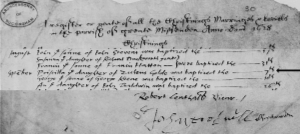
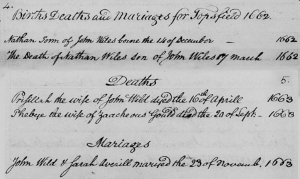
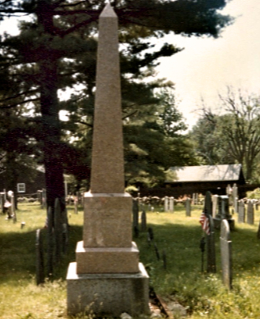

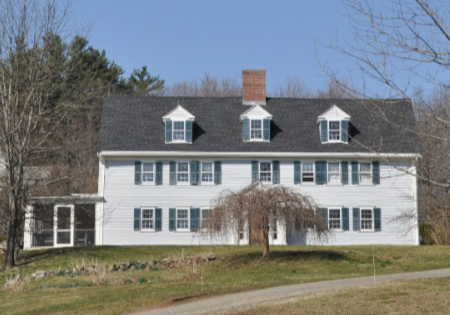 Phebe married Zaccheus Gould about 1619/20, probably in Hemel Hempstead, as the first three of their children were baptized at St. Mary's Church, in Hemel Hempstead. They moved out of Hemel Hempstead some time prior to 1628, as their last two children were baptized at St. Peter and St. Paul church in Great Missenden, Buckinghamshire County, England. Their children were — Phebe, baptized on September 17, 1620, married Thomas Perkins and then Joseph Towne; Mary, baptized on December 19, 1621, married John Redington, and spread witchcraft rumors about Sarah Wildes; Martha was baptized on June 15, 1623, and married John Newmarsh; ancestor Priscilla was the first to be baptized in Great Missenden; and lastly, John who was baptized there on June 10, 1635, and married Sarah Baker in Massachusetts.
Phebe married Zaccheus Gould about 1619/20, probably in Hemel Hempstead, as the first three of their children were baptized at St. Mary's Church, in Hemel Hempstead. They moved out of Hemel Hempstead some time prior to 1628, as their last two children were baptized at St. Peter and St. Paul church in Great Missenden, Buckinghamshire County, England. Their children were — Phebe, baptized on September 17, 1620, married Thomas Perkins and then Joseph Towne; Mary, baptized on December 19, 1621, married John Redington, and spread witchcraft rumors about Sarah Wildes; Martha was baptized on June 15, 1623, and married John Newmarsh; ancestor Priscilla was the first to be baptized in Great Missenden; and lastly, John who was baptized there on June 10, 1635, and married Sarah Baker in Massachusetts.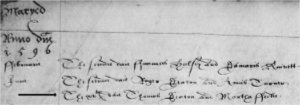
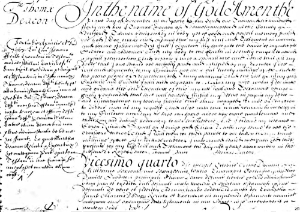
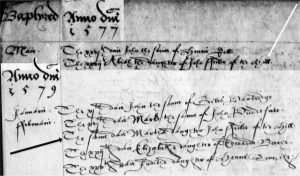
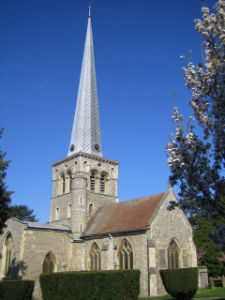 Martha married Thomas Deacon on June 15, 1596, in Hemel Hempstead, lived at Corner Hall and had at least nine children, all baptized there at St. Mary’s Church, on the dates given — ancestor Phebe was the oldest; Anne on June 22, 1600; Thomas on February 14, 1601/02, who died a few days later and was buried there on February 17th; Elisha on January 9, 1602/03, married Mary Hull on January 16, 1631/2, died and was buried on October 23, 1658, in St. Mary's Churchyard; daughter Saray was baptized on December 25, 1604; another Thomas on December 25, 1609, attended Trinity College, Oxford, matriculated on November 23, 1627, at 18 years-old, received his B.A. on December 6, 1630, at 21 years-old, was 6 feet tall, as displayed by his original tombstone, died unmarried on September 28, 1632, and was buried in the vaulted chamber on the north side of the Chancel in St. Mary's church on October 2nd; Martha was baptized on August 22, 1613; and unnamed twins, a boy and girl, who were born on October 22, 1619. The daughter died the day she was born, but the son survived one day and died on the 23rd. They both were buried in St Mary’s Churchyard. (Mouse over St. Mary's Church image on left for more about it.)
Martha married Thomas Deacon on June 15, 1596, in Hemel Hempstead, lived at Corner Hall and had at least nine children, all baptized there at St. Mary’s Church, on the dates given — ancestor Phebe was the oldest; Anne on June 22, 1600; Thomas on February 14, 1601/02, who died a few days later and was buried there on February 17th; Elisha on January 9, 1602/03, married Mary Hull on January 16, 1631/2, died and was buried on October 23, 1658, in St. Mary's Churchyard; daughter Saray was baptized on December 25, 1604; another Thomas on December 25, 1609, attended Trinity College, Oxford, matriculated on November 23, 1627, at 18 years-old, received his B.A. on December 6, 1630, at 21 years-old, was 6 feet tall, as displayed by his original tombstone, died unmarried on September 28, 1632, and was buried in the vaulted chamber on the north side of the Chancel in St. Mary's church on October 2nd; Martha was baptized on August 22, 1613; and unnamed twins, a boy and girl, who were born on October 22, 1619. The daughter died the day she was born, but the son survived one day and died on the 23rd. They both were buried in St Mary’s Churchyard. (Mouse over St. Mary's Church image on left for more about it.)